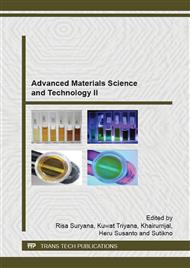[1]
D.C. Blackley, Polymer Latices Science and Technology. Second Edition. Volume 3: Applications of Latices. Chapman & Hall : London, (1997), p.156.
Google Scholar
[2]
J. Tan, X. Wang, Y. Luo, D. Jia, Rubber/ Clay Nanocomposites by Combined Latex Compounding and Melt Mixing: A Masterbatch Process. Mater Des. 34 (2012) 825-831.
DOI: 10.1016/j.matdes.2011.07.015
Google Scholar
[3]
Z. Gu, G. Song, W. Liu, P. Li, L. Gao, H. Li, X. Hu, Preparation and Properties of Styrene Butadiene Rubber/ Natural Rubber/ Organo-Bentonite Nanocomposites Prepared from Latex Dispersions. Appl Clay Sci. 46 (2009) 241-244.
DOI: 10.1016/j.clay.2009.08.010
Google Scholar
[4]
C. Ma & R.A. Eggleton, Cation Exchange Capacity of Kaolinite. Clays and Clay Minerals. 47 (2) (1999) 174-180.
DOI: 10.1346/ccmn.1999.0470207
Google Scholar
[5]
C.O. Mgbemena, N.O. Ibekwe, R. Sukumar, A.R.R. Menon, Characterization of Kaolin Intercalates of Oleochemicals Derived from Rubber Seed (Hevea brasiliensis) and tea seed (Camelia sinensis) oils. J King Saud Univ Sci. 25 (2013) 149-155.
DOI: 10.1016/j.jksus.2012.11.004
Google Scholar
[6]
L.E. Yahaya, K.O. Adebowale, A.R.R. Menon, B.I. Olu-Owolabi, Natural Rubber/ Organoclay Nanocomposite from Tea (Camelia sinensis) seed oils. Amer J Mat Sci. 2 (2) (2012) 1-5.
DOI: 10.5923/j.materials.20120202.01
Google Scholar
[7]
A. Malicka-Soczka, L. Domka, A. Kozak, Kaolin Modified With Silane Compounds As a Filler Used In Rubber Industry. Physicochem. Probl. Miner. Process. 44(2010) 151-156.
Google Scholar
[8]
I. Surya, H. Ismail, A.R. Azura, Alkanolamide as an accelerator, filler-dispersant and a plasticizer in silica-filled natural rubber compounds. Polym Test 32 (2013)1313-1321.
DOI: 10.1016/j.polymertesting.2013.07.015
Google Scholar
[9]
S. Yuhai, L. Yuanfang, J. Demin, Preparation and Properties of Natural Rubber Nanocomposites with Solid-State Organomodified Montmorrilonite. J Appl Polym Sci. 107 (2008) 2786-2792.
DOI: 10.1002/app.26539
Google Scholar
[10]
M. Arroyo, M.A. López-Manchado, B. Herrero, Organo-montmorillonite as substitute of Carbon Black in Natural Rubber Compounds. Polymer 44 (2003) 2447-2453.
DOI: 10.1016/s0032-3861(03)00090-9
Google Scholar
[11]
J. Carretero-González, J.L. Valentin, M. Arroyo, K. Saalwächter, M.A. Lopez-Manchado, Natural rubber/ clay nanocomposites: Influence of poly(ethylene glycol) on the silicate dispersion and local chain order of rubber network. Eur Polym J. 44 (2008).
DOI: 10.1016/j.eurpolymj.2008.08.046
Google Scholar
[12]
N.M. Claramma & N.M. Mathew. Effect of Temperature on Sulfur Prevulcanization of Natural Rubber Latex, J Appl Polym Sci. 65 (1997) 1913-(1920).
DOI: 10.1002/(sici)1097-4628(19970906)65:10<1913::aid-app8>3.0.co;2-i
Google Scholar
[13]
D.M. Preiss, W.M. Sawyer, W.C. Simpson, Characteristics of Experimental cis-1, 4 Polyisoprene Latices. J Appl Polym Sci. 7 (1963) 1803-1814.
DOI: 10.1002/app.1963.070070520
Google Scholar


